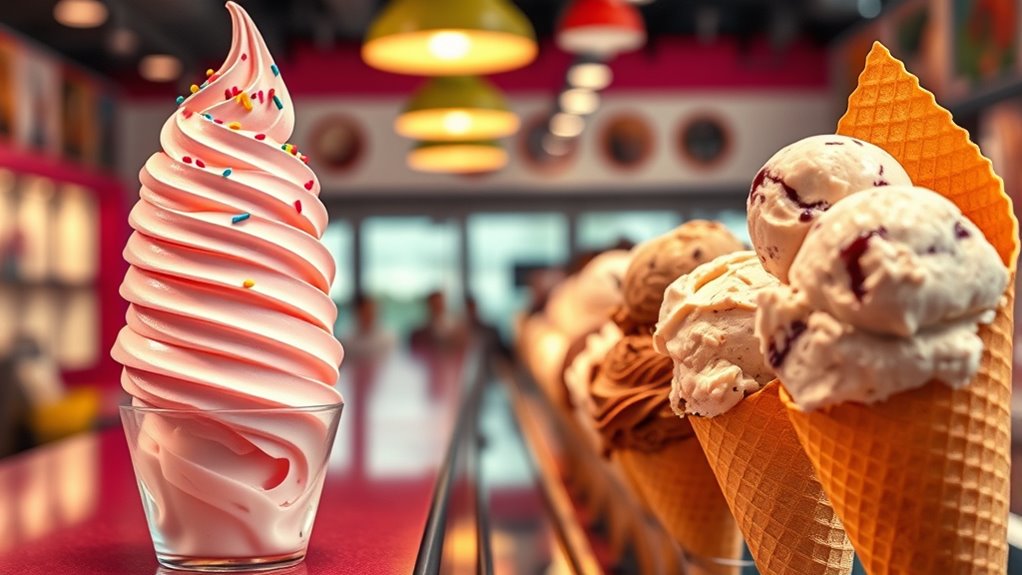Soft serve ice cream tends to sell more worldwide because it’s quick to produce, easy to serve, and popular in fast-food spots, appealing to many consumers seeking convenience and quick gratification. Its smooth texture and toppings make it a favorite for casual treats, while hard ice cream often caters to those wanting richer flavors and longer shelf life. Curious about what drives these preferences? Keep exploring to discover more about the differences and market trends.
Key Takeaways
- Soft serve generally sells more volume due to quick service and high throughput in fast-food outlets.
- Hard ice cream tends to generate higher revenue per unit with premium and artisanal flavor options.
- Soft serve is more prevalent in casual, high-traffic locations, boosting overall sales.
- Hard ice cream sales are stronger in supermarkets and specialty shops with longer shelf life.
- Market trends show increasing soft serve sales driven by convenience and popularity among younger consumers.

Have you ever wondered whether soft serve or hard ice cream is the better treat? The answer depends on a few factors, including what kind of experience you’re after. Soft serve tends to be lighter and creamier, served quickly from machines that give it that signature smooth texture. Hard ice cream, on the other hand, offers a richer, denser experience, often with a broader variety of flavors and textures. But when it comes to popularity and sales, the choice isn’t just about taste; it’s also about how people enjoy their ice cream.
Soft serve is light and creamy, while hard ice cream offers richness and variety—both satisfy different cravings.
Soft serve has a quick, fun appeal. It’s often associated with cones and fast-food spots, making it a go-to for a casual treat. Its airy texture allows for easy layering with ice cream toppings like sprinkles, syrups, or crushed cookies, enhancing the overall experience. Many people love soft serve for its simplicity and the way it melts quickly in your mouth. Its popularity is fueled by convenience—there’s no need for scooping or waiting—and it’s often more affordable, making it accessible to a broad audience. Soft serve machines are quick to produce, allowing establishments to serve high volumes of customers fast, which boosts sales in busy locations.
Hard ice cream, however, tends to draw those looking for variety and richness. With a broader gelato variety and more complex flavors, it appeals to connoisseurs and those seeking a more indulgent treat. The ability to add a multitude of ice cream toppings—like fresh fruit, nuts, caramel swirls, or chocolate chips—gives consumers the chance to customize their experience. This customization often encourages repeat purchases, especially at specialty shops that pride themselves on unique flavors and toppings. Plus, hard ice cream generally lasts longer on shelves and can be stored for longer periods, making it a staple in supermarkets and ice cream parlors alike. Its dense texture and extensive flavor options can create a more memorable experience, leading to higher sales in certain markets. Additionally, marketing strategies play a significant role in shaping consumer preferences and boosting sales for both types of ice cream. Moreover, storage and shelf life are crucial factors that influence how each type performs in retail settings. The trend toward premium and artisanal products also influences sales dynamics, with many consumers seeking unique and high-quality options.
In recent years, the rise of sustainable and eco-friendly packaging has also impacted consumer choices and sales strategies for both soft serve and hard ice cream. Ultimately, the popularity of soft serve versus hard ice cream varies by region and demographic. Both types thrive because they cater to different tastes and occasions. If you’re looking for a quick, satisfying treat, soft serve might be your favorite. If you prefer a more indulgent, customizable experience, hard ice cream probably wins your favor. Either way, both are beloved and continue to dominate the ice cream market, each with their own loyal fans.
Frequently Asked Questions
Which Type Has a Longer Shelf Life?
When considering shelf life, soft serve and hard ice cream differ mainly because of storage methods and packaging differences. Hard ice cream typically lasts longer since it’s stored at consistent freezing temperatures in sealed containers, preventing spoilage. Soft serve, usually kept at higher temperatures, has a shorter shelf life due to quicker spoilage risks. Proper packaging and freezing guarantee longer freshness, making hard ice cream generally more durable for storage.
Are Soft Serve and Hard Ice Cream Made From the Same Ingredients?
You’re asking if soft serve and hard ice cream are made from the same ingredients. Well, they’re not exactly cut from the same cloth. The ingredient differences mainly lie in fat content and stabilizers, while production methods differ—soft serve is whipped and served immediately, giving it a smoother texture. So, even though they share basic ingredients like milk and sugar, their unique production methods shape their distinct qualities.
How Do Seasonal Changes Affect Sales of Each Type?
Seasonal changes notably impact your ice cream sales. When outdoor temperatures rise, soft serve often sees a boost due to its quick serving and invigorating nature, while hard ice cream may see a dip unless it offers seasonal flavor variations like pumpkin or peppermint. Conversely, colder weather favors hard ice cream, especially with seasonal flavors. You should adapt your offerings to match outdoor temperature impacts and capitalize on seasonal flavor variations to maximize sales year-round.
Do Different Age Groups Prefer Soft Serve or Hard Ice Cream?
You might notice that age preferences influence whether people lean toward soft serve or hard ice cream. Younger audiences often prefer soft serve for its fun texture and quick indulgence, while older customers tend to choose hard ice cream for flavor variety and richer tastes. Their flavor choices also differ, with kids favoring sweeter options and adults seeking more sophisticated flavors. Recognizing these preferences helps you tailor your offerings to each age group effectively.
Which Type Is More Environmentally Sustainable?
When considering environmental sustainability, soft serve generally has a smaller carbon footprint due to less packaging and waste, while hard ice cream often involves more energy-intensive production and packaging. Recycling practices can further reduce environmental impact for both types. You can choose eco-friendlier options by supporting brands with sustainable packaging and recycling initiatives, helping lower overall carbon footprints. Your choices matter in making ice cream consumption more environmentally responsible.
Conclusion
So, whether you prefer the creamy swirl of soft serve or the rich scoop of hard ice cream, your choice influences sales and satisfaction alike. Soft serve tempts with speed and affordability, while hard ice cream offers tradition and variety. Both have their unique appeal, their loyal fans, and their place in the market. Ultimately, it’s about what you crave—smooth or solid, quick or classic. Remember, in ice cream, variety truly is the spice of life.









